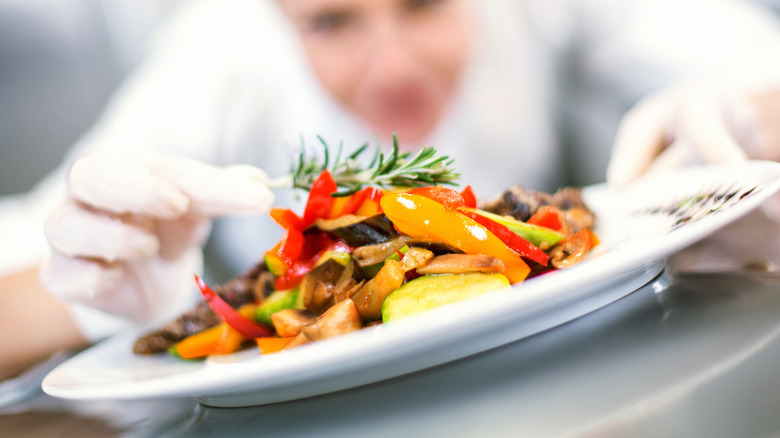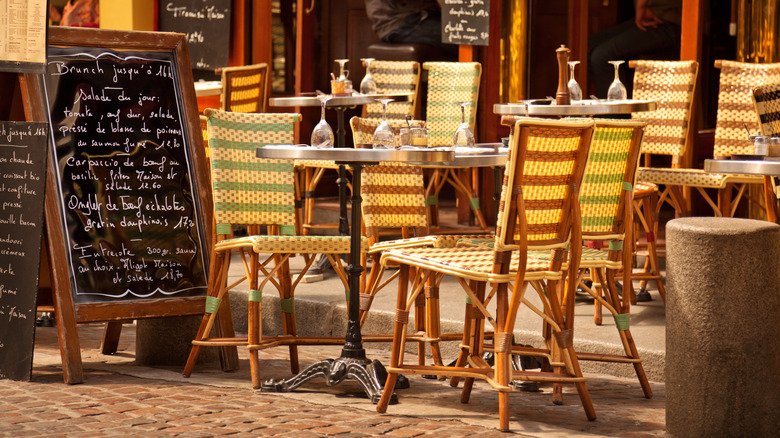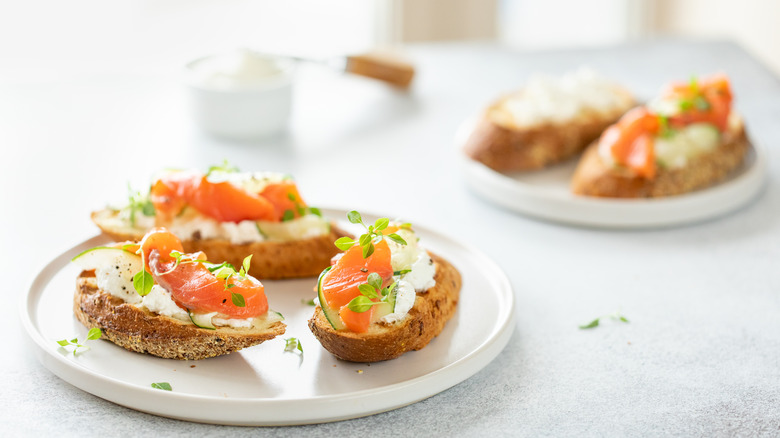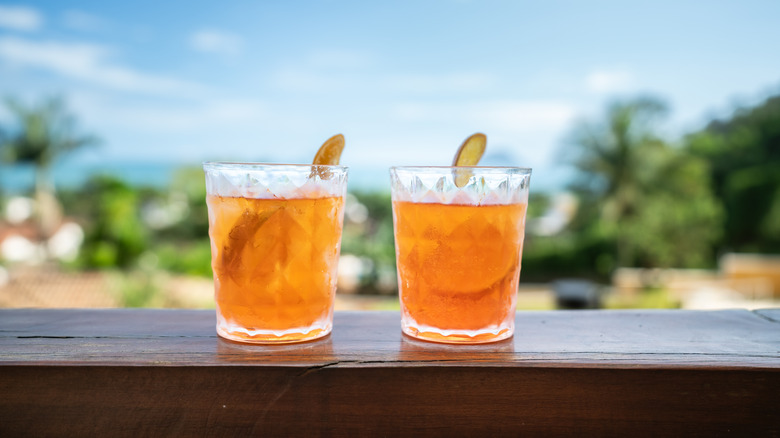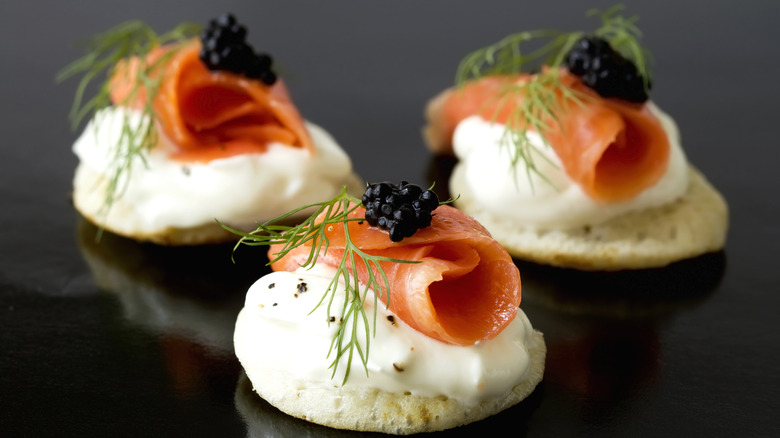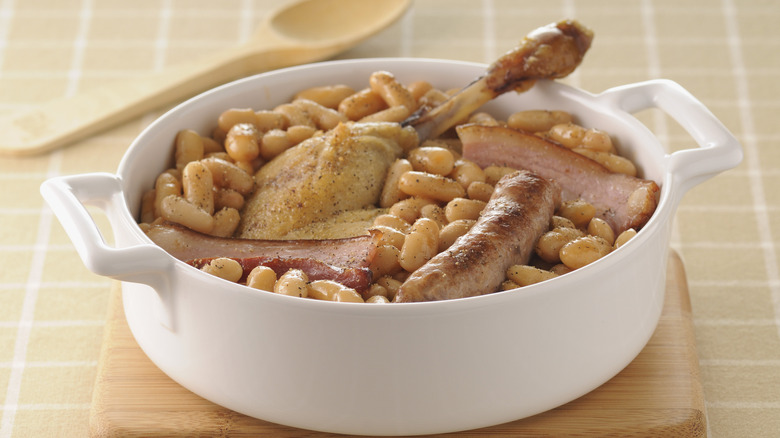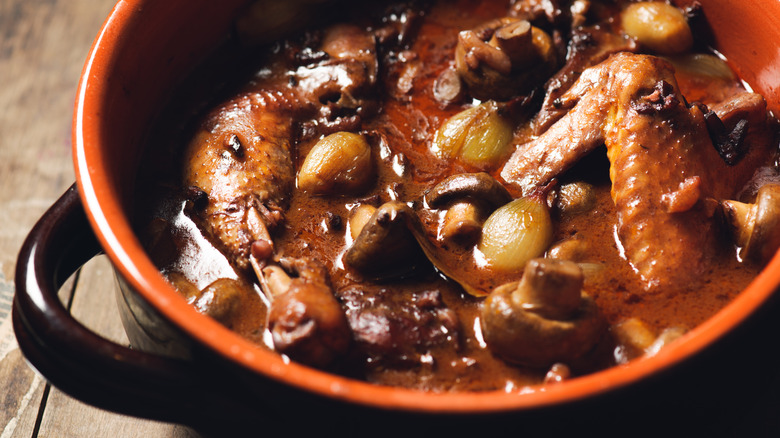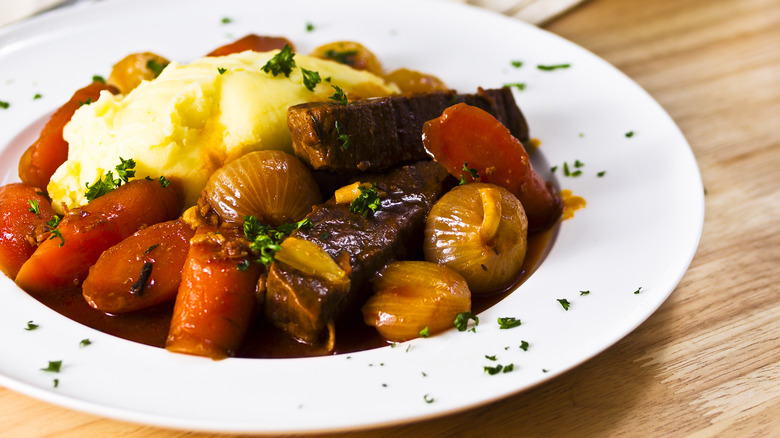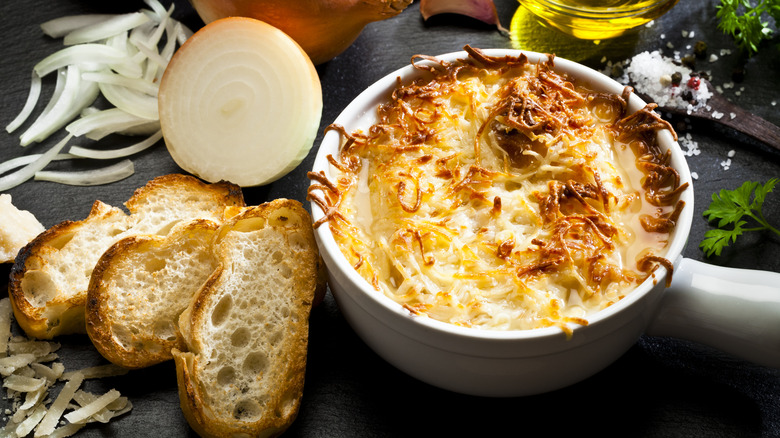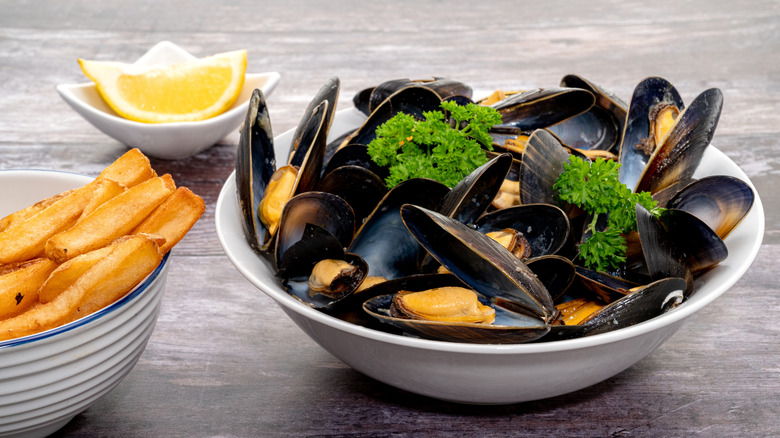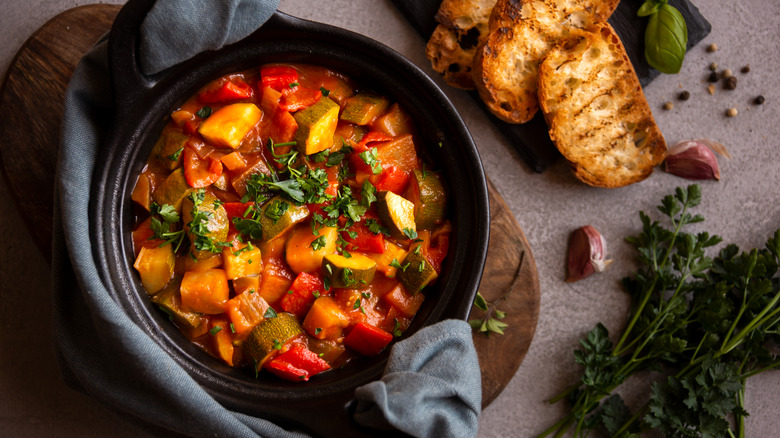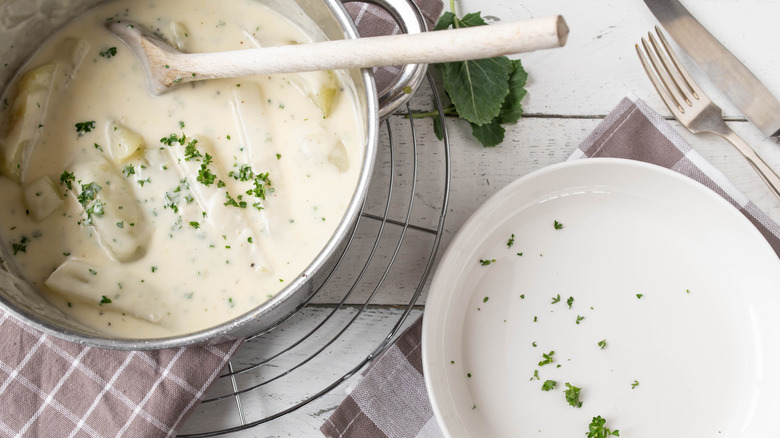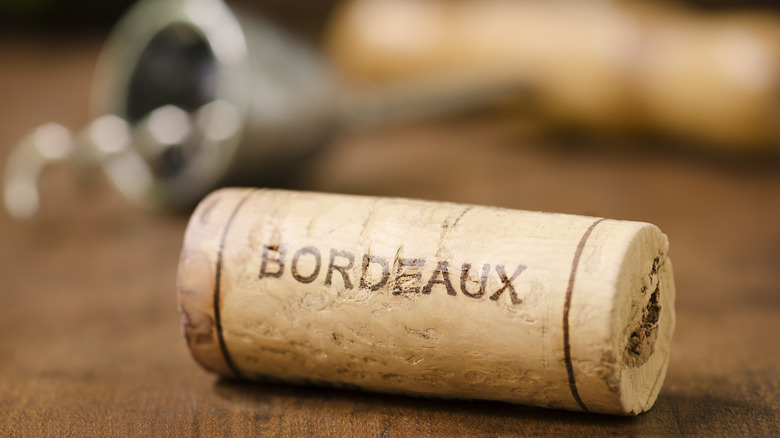14 Essential Words And Phrases To Know At A French Restaurant
French cuisine is renowned for its elegance, sophistication, and rich heritage. Rooted in centuries of tradition, French gastronomy is characterized by its emphasis on high-quality ingredients, meticulous preparation techniques, and artistic presentation. And as enjoyable as all this is to the palate, for the uninitiated, coming face-to-face with French cuisine can be intimidating. For instance, those preparation techniques might be mentioned on a menu, and if you don't know what to expect from a flambéed dessert, you could end up running out of the restaurant with your hair on fire, quite literally.
One way to overcome potential mistakes or faux-pas (French for a misstep or embarrassing mistake), is to gain familiarity with French culinary terms. Understanding phrases like "amuse-bouche" (a small, complimentary appetizer) or "prix fixe" allows diners to navigate menus with confidence and make informed choices. Knowledge of the language can also enhance your dining experience, not to mention impress your date. The more terms you know, the more insight you'll have into the preparation and composition of the available dishes. So let's take a look at some of the most common and important French terms you should know ahead of your reservation at Le Bernardin or another one of your favorite French restaurants.
Learn the sections of the menu
Let us begin with the word menu. No doubt you already know the meaning of this word, and you might even think it's English. But actually, English pilfered the term from French, along with a whole slew of other food-related terms, like supper or dinner, though the last was originally used to refer to breakfast.
When dining at a French restaurant, "menu" does not mean what you think it means. Unless you're looking at a menu specifically designed for English speakers, the term refers to a pre-set menu. Compare this to tasting menus, which are a kind of pre-set menu intended to give you a wide array of small bites, usually to showcase the kitchen's or chef's talents at particular dishes. The French term for such a menu is "menu dégustation." If you're not comfortable with a predetermined menu and want to order your dishes individually, you'll need an a la carte menu, which allows you to order your choice of appetizers, mains, and desserts. This should make more sense when you consider that the word for "menu" in France is "la carte."
Clear as mud? Then let's add the concept of a "prix-fixe" menu, which means "fixed price." This is similar to a pre-set menu, except that it tends to be a bit more casual. Some restaurants offer several options or a combo as part of a prix-fixe menu, always sold for a set price. These are like table d'hôte courses in English restaurants — confusingly, though, in France, "table d'hôte" refers not to a prix-fixe menu but to a collective dining experience, such as at a bed and breakfast.
Proceed in the correct order
When reading a French menu, even if you don't know the language, you can guess from the order of things which dishes might be starters and which might be mains. But then again, maybe not. First of all, it's important to be on the lookout for "false friends," or words that might look like a familiar English word but mean something totally different in French. A case in point is the word "entrée," which in English refers to a main dish. In French, however, this word means "entry" or "beginning." On a French menu, "entrée" indicates a starter.
Another point of confusion might be all the small dishes with big words. For instance, you might come across an amuse-bouche, which means "mouth amuser." These dishes are very small, bite-sized items served before a more substantial appetizer. This same food may also be referred to as an hors d'ouvre, meaning "outside the work," or a canapé, all of which can mostly be used interchangeably. The main thing to know about these words is that they indicate complementary additions to your meal and are usually selected by the chef — but they, by definition, don't constitute a full meal on their own.
Start with an aperitif
Appetizers, amuse-bouches, or other small bites are not the only ways to start a meal. The aperitif is another key component of the early stages of dining at a French restaurant. This is an alcoholic beverage designed to get your taste buds ready for your next dish, open your mind to what's to come, and pique your appetite so that you can enjoy your food to the max.
But an aperitif is not just any alcoholic drink. It is typically less strong than its after-dinner counterpart, the digestif, and can comprise something simple like a light glass of bubbly wine or be as complex as a craft cocktail. By way of example, we give you our Americano aperitif cocktail, which is made with Campari, sweet vermouth, soda water, and orange bitters. Another typical aperitif that you might encounter in France is the kir, which at its most basic is made with blackcurrant liqueur and white wine. That can also be disguised as a kir royale, where champagne is used instead of white wine, or the kir imperial, which subs out the blackcurrant liqueur for raspberry-based Chambord.
Know what constitutes a starter
Many menus come with labeled sections, meaning that starters will be grouped together under the word "starter" and so on. But with modern menus, some of which are as spare and minimalist as possible, that is not always the case. For that reason, it's helpful to know what kind of dish typically constitutes a starter so you can match your order to the size of the dish you want.
We'd like to point out a few key terms you may find in the starter or entrée section of a French menu. For one, you may come across the word pâté. While you may be familiar with this term, as it is not uncommon in America, you should also know that pâté can come in different forms: It can be made with various types of poultry, pork, or even fish, and it typically contains liver as a binding agent. The term pâté, meaning "paste" or "dough," comes from the crust in which it used to be contained, but nowadays it is served alone so that it can easily be spread on toast or bread. Don't confuse pâté with terrine — the latter is a spreadable meat starter cooked in a rectangular terrine, or earthenware pot, hence the name. The main difference between pâté and terrine is that the former is completely pureed, while terrines contain layers that can include whole nuts, olives, or even boiled eggs.
Be ready for the main course
Now that you've established that an "entrée" is not an entree, you'll need a new word to describe your mains. That word is "plat," which literally means plate or dish. You may find a section of the menu entitled "plats," or you might see the term "plat du jour," which literally means "dish of the day," which is more commonly known as a special in our neck of the woods.
As for what constitutes a main course, we could really get into the weeds with that, so we're going to focus on a few common items. For instance, a cassoulet is a classic French stew including duck confit and white beans. As with many terms for French dishes, the name comes from the thing in which it's cooked: a cassoulet is a type of earthenware dish that is, incidentally, just like a casserole dish. Coincidence? Perhaps not. Another typical dish is the quiche. While there are many quiche recipes worth salivating over, the family comprises savory pies made with eggs and cheese combined with almost any type of filling, from bacon bits to zucchini.
Familiarize yourself with popular poultry dishes
Poultry takes pride of place in French cooking with such joys as delicious coq au vin or duck confit. But if you've never heard of these, don't fret — that's what we're here for. The first literally means "rooster in wine," though you're welcome to use a chicken of any gender if you're making this dish at home. That said, we recommend you order this at a restaurant if you see it on the menu since, while you can make coq au vin on your own in a crockpot, it is a long and laborious recipe.
Another popular poultry dish is duck confit, which literally means preserved duck. But it's not preserved just any old way. This particular method involves salting the meat and cooking it slowly in a large dose of fat, such as lard or olive oil. Indeed, you might find that such a process can be applied to most meats, thus you may see phrases like pork confit or goose confit.
Get to know beef in the form of boeuf bourguignon
Because boeuf bourguignon is such a key recipe in French cooking, we've dedicated a whole section just to singing the praises of this elemental dish. First of all, let us be clear about what it is: beef that has stewed in its own juices for several hours along with Burgundy wine, bacon, cognac, vegetables, herbs, and mushrooms.
This process ensures the meat is packed with flavor and comes out with a rich, melt-in-your-mouth texture. If you order a boeuf bourguignon at a good French restaurant, you can't go wrong. If instead, you want to try your hand at making boeuf bourguignon at home, be ready to put aside an entire day for the project. Between all the chopping, preparation, braising, and stewing, it can be a lengthy process that requires some advanced cooking skills. But it's all well worth the wait.
Be aware of terms for different soups
In French fine dining establishments, there is hardly such a thing as just "soup." While the word for this in French is conveniently "soupe," you might not necessarily see that specific term on a menu, unless you're dealing with soupe à l'oignon, which is French onion soup. Rather, you're more likely to see a more specific kind of soup listed with its own special name.
For instance, you might encounter vichyssoise, which is a pureed leek and potato soup that is served chilled. But despite the name, you should know that this dish wasn't invented in France. The origins of vichyssoise are hotly contested, but the first known vichyssoise was served by chef Louis Diat in New York City in the early 1900s, inspired by a common French soup. Another important soup to know about is bisque. Bisque differs from regular soup in that it is always thick and creamy and must be made with a shellfish base. Lobster bisque is a highly prized dish commonly found in French restaurants.
Not all fish will appear under the name poisson
Even if you're familiar with the French word for fish, "poisson," be careful when reading a menu in a French restaurant. Although you may see this word as a section heading, that is not always the case, so it may be helpful to learn some specific names of fish dishes, just in case.
One common meal is the sole meunière, which means sole in the style of a miller or a miller's wife, refers to how the sole is prepared by being dunked in flour before it's cooked. Another famous fishy dish is the salad Niçoise, which is named after its place of origin, Nice, and contains chunks of tuna, hard-boiled eggs, olives, potatoes, green beans, tomatoes, red onions, capers, and various herbs. And don't forget about another classic, the moules frites, which technically means fried mussels, but in actuality is a dish made with steamed mussels, white wine, butter, and parsley accompanied by a side of French fries.
You may already know the terms for some sides
Unless you've been living under a rock, you've probably heard of the popular Pixar animated feature "Ratatouille," in which an enterprising young rat showcases his talents as a chef by improving the fortunes of one of the most prestigious (made-up) restaurants in Paris. Anyone who's seen the film knows that ratatouille is also the name of a traditional French vegetable dish made with eggplant, zucchini, tomato, bell peppers, and various spices and herbs. It is typically served as a side and is a very flavorful way to get a bunch of veggies and nutrients in one single, glorious bite.
Another famous French side is potatoes au gratin, which comes from the French "gratter," meaning to scrape or grate. In this case, what is being grated is the cheese, on top of the potatoes. Indeed, there is no such thing as a potato gratin without plenty of cheese — "au gratin" also refers to the golden brown cheesy crust that forms over the dish.
Notice how many English dessert terms come from the French
One can hardly make a dessert in America without using an ingredient or technique with a name that stems from the French — unless, maybe, you're making Jell-O from the box? Starting with some delectable French cakes, you have the gâteau Breton, gâteau Basque, and the scrumptious gâteau invisible, which hides apple in folds of custard.
Even some casual pastry fans likely know the tarte tatin, which is an apple-based dessert that the chef flips upside down onto a plate once it comes out of the oven. (Unsurprisingly, it might have been invented by accident.) Another important dessert term is the soufflé, which can be either sweet or savory but is most often served as a dessert. This term literally means "puffed up" and denotes a light, bouncy dessert.
Lastly, you'd better learn what "flambé" means before you order a dish that uses that word, or you may end up with no eyebrows by the end of the night. It basically means "flames" and refers to a dessert that has been doused in alcohol and lit on fire, ever so briefly, to achieve caramelization. For instance, bananas Foster, a classic New Orleans dessert, is a popular flambéed treat in the U.S. In French restaurants, crêpes Suzette are usually flambéed tableside, so don't be surprised if your waiter shows up to your table with a blowtorch in hand.
Recognize popular sauces
The French use sauces on all types of dishes. You will find them from your amuse-bouches all the way to your dessert, and indeed, there are too many types of sauces to talk about in this small space, so we'll focus on two of the most common and popular ones. One such sauce is béchamel, named after the 17th-century French nobleman who perfected it. This sauce is primarily made of butter, milk, and flour and acts as a foundation for myriad French dishes, as well as some Greek and Italian ones.
In the realm of desserts, you have the coulis, which comes from the French word for "flow." Indeed, a lovely raspberry coulis beautifully flows from the top of a thick, fluffy slice of cheesecake. Coulis, unlike other sweet berry sauces, has been pureed and strained, which makes it flow beautifully and gives it a more refined texture. Savory coulis sauces, on the other hand, are typically made with pureed vegetables.
Guide to digestifs
A full French meal, with hors d'ouvres and all, can be a lot to swallow — literally. After all those courses, many of which contain plenty of butter, you're probably going to need some help digesting it. That's where digestifs come in handy. These are hard liquors, bitters, or fortified wines served at the end of the meal to help you digest what you just ate. There is no scientific evidence, however, to suggest digestifs help you digest food better, according to Eating Well. They at least allow you to relax, enjoy your company, and take a breath.
You might want to try a classic French after-dinner drink, the Grand Marnier, which is an orange-flavored liqueur. Or you can always turn to the Italians for help on this one, as they seem to have the market cornered on digestifs. Grappa, a hard liquor from the north of Italy, is particularly useful, while anything containing amaretto — like the amaretto sour — will also do the trick nicely.
Order wine like a pro
You can hardly partake in a French meal without also enjoying a fine glass of wine. It's important to know a few key wine terms in order to get through the evening. First of all, you may want to ask for the carte des vins, the wine list.
Starting with sparkling wines, you should know that Champagne comes in many varieties. For instance, if you like a sweeter drink, you might want to go for a dry or extra-dry Champagne. Conversely, brut or extra brut are the options to choose if you like your wines dry. Doesn't make sense? We couldn't agree more, but there are historical reasons for these categorizations and it's too late to change it.
As for reds, or vins rouges, you should know that Bordeaux wines stand as the quintessential French reds. Wines produced in the Bordeaux region can include white wines, roses, and sparkling wines, but they are most typically red wines made with a blend of Cabernet Sauvignon, Cabernet Franc, and Merlot grapes. For more information about your restaurant's wines, ask to speak to the sommelier, the restaurant's wine specialist. They should be able to help you make head or tail of a wine list.
